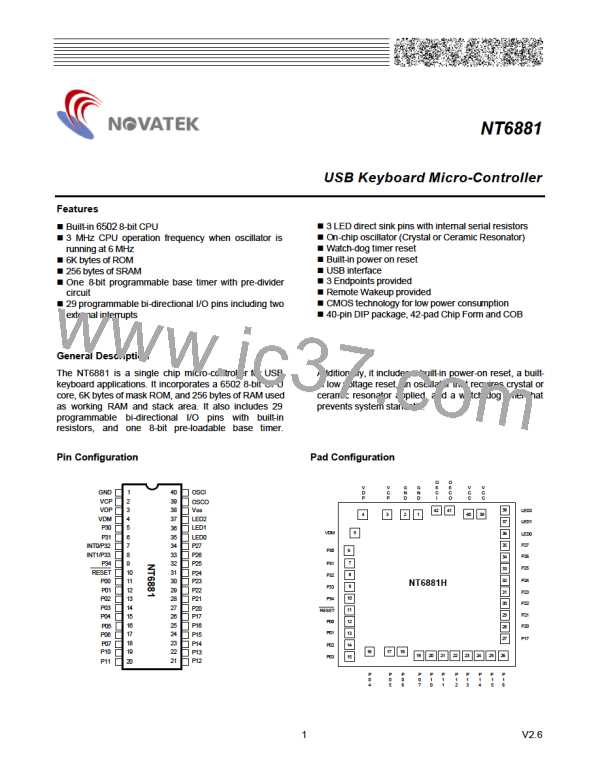NT6881
9.7. IN1 Token Interrupt
When an IN TOKEN for endpoint 1 is done, it will set the IN1 flag. If this interrupt is enabled by writing "1" to EIN1 ($0005H,
bit2), it will interrupt 6502 CPU. When an interrupt occurs, the CPU jumps to $FFFEH & $FFFFH to execute the interrupt
service routine, the IN1 flag must be cleared by software.
9.8. IN2 Token Interrupt
When an IN TOKEN for endpoint 2 is done, it will set the IN2 flag. If this interrupt is enabled by writing "1" to EIN2 ($0005H,
bit3), it will interrupt 6502 CPU. When an interrupt occurs, the CPU jumps to $FFFEH & $FFFFH to execute the interrupt
service routine, the IN2 flag must be cleared by the software.
9.9. STUP (SETUP) Token Interrupt
When a SETUP TOKEN for endpoint 0 is done, it will set the STUP flag. If this interrupt is enabled by writing "1" to ESTUP
($0005H, bit6), it will interrupt 6502 CPU. When an interrupt occurs, the CPU jumps to $FFFEH & $FFFFH to execute the
interrupt service routine, the STUP flag must be cleared by the software.
9.10. SUSP Interrupt
When USB SIE detects a suspend signal, it sets the SUSP flag. Then 6502 CPU is interrupted if the interrupt has been
enabled already by writing “ 1” to ESUSP ($0005H, bit7). If ESUSP flag is cleared, 6502 CPU can’ t be SUSP interrupted
even if SUSP flag is set. SUSP flag can be set by H/W only and can’ t be set/cleared directly by S/W except for writing “ 1” to
CSUSP ($0004H, bit 7) flag to clear SUSP flag. When an interrupt occurs, the CPU jumps to $FFFEH & $FFFFH to execute
the interrupt service routine, the SUSP flag must be cleared by software.
10. I/O PORTs
The NT6881 has 32 pins dedicated to input and output. These pins are grouped into 5 ports, as follows:
PORT0 (P00~P07)
PORT0 is an 8-bit bi-directional CMOS I/O port that is internally pulled high by PMOS. Each pin of PORT0 can be bit
programmed as an input or output port under software control. When programmed as output, data is latch to the port data
register and output to the pin. PORT0 pins with “ 1” written to them are pulled high by the internal PMOS pull-ups, and can
be used as inputs in that state then these input signals can be read. The port will output high after reset.
PORT1 (P10~P17): Functions the same as PORT0.
PORT2 (P20~P27): Functions the same as PORT0.
PORT3 (P30~P34): Functions the same as PORT0. Except for P33/P32 is shared with INT1/INT0 pin. It is also a Schmitt
Trigger input with an interrupt source of falling edge sensitive.
LED: There are three LED direct sink pins which require no external serial resistors.
The address is mapped to $000DH.
11

 ETC [ ETC ]
ETC [ ETC ]